Scottish household survey 2016: annual report
Results from the 2016 edition of the continuous survey based on a sample of the general population in private residences in Scotland.
7 Internet
Main Findings
Home internet access in Scotland is high and continuing to increase. 82 per cent of Scottish households reported having internet access at home in 2016, an increase of 2 percentage points from the prior year. Home internet access has increased over the
past decade from 42 per cent in 2003.
The vast majority of households with internet access at home reported having a
broadband connection (98 per cent). Across all households (both households that have access to the internet and those who do not), 81 per cent had broadband at home.
Home internet access varies with household income. In 2016, 63 per cent of
households with incomes of £15,000 or less had home internet access, increasing to 98 per cent of households with incomes over £40,000.
Eighty-four per cent of adults reported using the internet for personal or work use in 2016, while 16 per cent reported not using the internet at all.
Gaps in internet access and use remain amongst certain groups including those in
deprived areas, those in social housing and those on low incomes.
Methods used to access the internet are continuing to change. The proportion of adults accessing the internet through tablets and mobile phones have continued to increase.
The most common activities undertaken by those who have access to the internet
include sending and receiving emails (90 per cent) and searching for information (80
per cent).
Among those that have access, a lower proportion of adults in social housing were confident in their ability to use the internet than those in private rented housing and those who own their own homes. Those aged over 45 and those on incomes between
£6,000 - £20,000 consistently reported being less confident than average.
Not liking or not needing to use the internet or computers remain the main reasons
for not using the internet.
There is variation in the uptake of online security measures. Whilst 68 per cent of respondents said they avoid opening emails or attachments from unknown people, only a third (33 per cent) regularly change their passwords for online accounts. Those aged 75 and above were most likely to say they took none of the security measures discussed.
7.1 Introduction and Context
The Scottish Government is committed to ensuring that all of Scotland is well positioned to take full advantage of all opportunities offered by the digital age. This includes a vision of a Scotland where businesses and individuals are making effective use of digital tools, public services are designed around the needs of users, high quality connectivity is provided across the whole of the country, the current gender gap in digital skills and careers is addressed and where digital technology is supporting inclusive economic growth, social cohesion and future innovation [51] .
Part of the Scottish Government’s Digital Strategy [52] is to increase digital participation in order to enable social mobility and tackle persistent inequalities. Digital participation refers to people’s ability to gain access to digital technology and use it effectively and creatively. Being able to use the internet provides access to a range of political, educational, cultural and economic resources and is thereby an important facilitator of social inclusion. Ultimately, increased digital participation can improve people’s quality of life, boost economic growth and allow for more effective delivery of public services.
The Scottish Government has an ambition to make Scotland a world leader in cyber resilience, with a global reputation for being a secure place to work, learn and do business.
The SHS provides information on a number of relevant areas of digital participation that can be used to measure progress. This chapter begins by looking at internet access and use by key demographic factors such as age, gender, income and deprivation. It then examines where and how users access the internet, including the activities for which the internet is being used and how confident users are undertaking different activities. Finally, it looks at the reasons why people do not use the internet and the security measures people take to protect themselves when online.
7.2 Internet Access and Usage
7.2.1 Internet Access
- Home Internet access at an all-time high and has increased steadily over time.
The SHS has asked whether households currently have access to the internet from their home every year since 2003. In 2016, the proportion of households with home internet access was 82 per cent ( Figure 7.1) having increased steadily from 42 per cent of households surveyed in 2003.
Figure 7.1: Households with home internet access by year
2003-2016 data, Households (minimum base: 3,270)

Variations in internet access
- Households with higher income more likely to have internet access.
- Households in Scotland’s 20 per cent most deprived areas continue to be less likely than those in the rest of Scotland to have home internet access.
- Internet access varies by tenure. Eighty-eight per cent of both owner occupied households and privately rented households reported having home internet access compared to only 65 per cent of those in social rented housing.
- The proportion of households with home internet access is highest in remote rural areas.
Variations in internet access by income
Home internet access tends to increase with household income ( Figure 7.2), with the exception of the lowest income bracket (£0 - 6,000). This result is likely to be driven, in part, by students (of whom 98 per cent have home internet access) being overrepresented in the lowest income bracket (making up almost a quarter of it) and the permanently retired (of whom only 64 per cent have access) making up a smaller proportion of the bracket compared to the £6,001 - £10,000 and £10,001 - £15,000 brackets. In 2016, 63 per cent of households with incomes of £15,000 or less had home internet access, increasing to 98 per cent of households with incomes over £40,000. Since 2007, the gap in access between the lowest and highest income brackets has decreased from 67 per cent to 30 per cent in 2016.
Figure 7.2: Households with home internet access by net annual household income
2016 data, households (minimum base: 90)
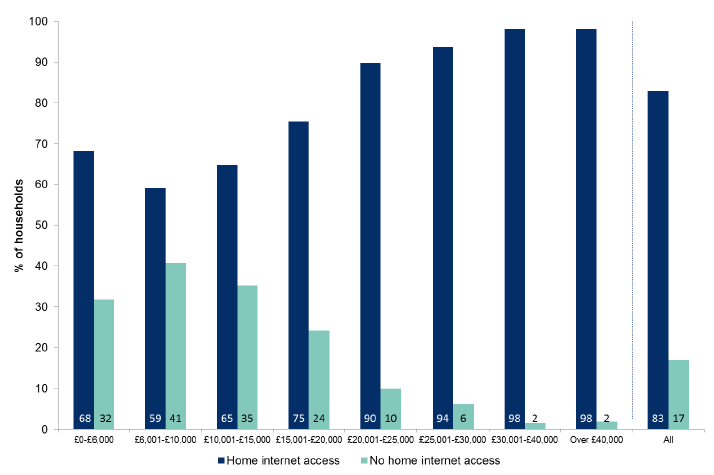
Variations in internet access by level of deprivation
Figure 7.3 shows that households in Scotland’s 20 per cent most deprived areas continue to be less likely than those in the rest of Scotland to have home internet access, the proportions with access being 73 per cent and 85 per cent respectively.
Figure 7.3: Households with home internet access by Scottish Index of Multiple Deprivation ( SIMD) 20 per cent most deprived areas
2016 data, Households (minimum base: 700)
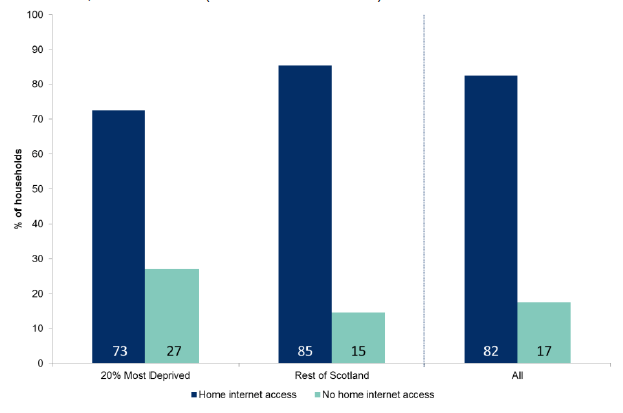
Variations in internet access by tenure
Figure 7.4 shows that that internet access varies by tenure. Eighty-eight per cent of both owner occupied households and privately rented households reported having home internet access compared to only 65 per cent of those in social rented housing.
Figure 7.4: Households with internet access at home by tenure
2016 data, Households (minimum base: 40*)

*The category with the minimum base is not shown in the chart because the figures have been suppressed due to low sample size.
Variations in internet access by urban – rural area classification
Figure 7.5 shows the prevalence of home internet access by area, based on Urban Rural Classification [54] . The proportion of households with home internet access is highest in remote rural areas. In 2016, 86 per cent of households in remote rural areas had home internet access, an increase of seven percentage points from the prior year.
Figure 7.5: Households with home internet access by Urban Rural Classification
2016 data, Households (minimum base: 190)
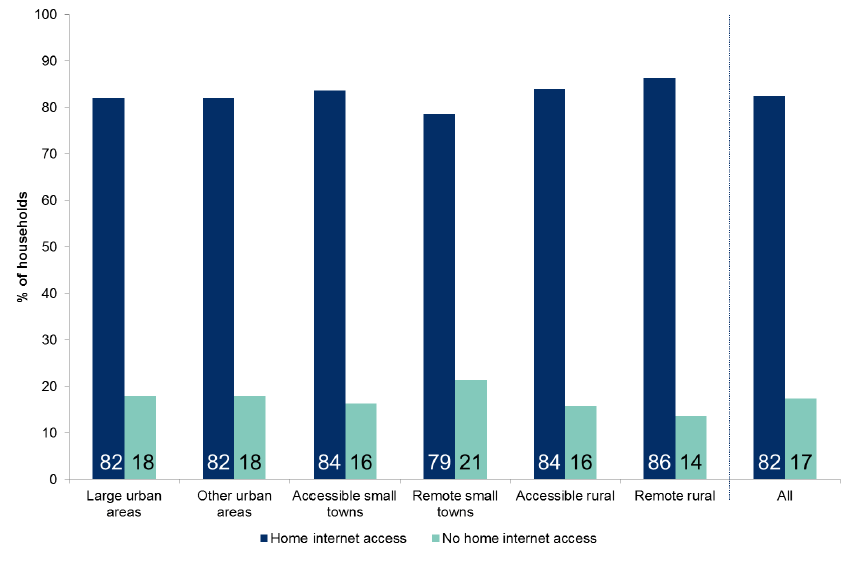
Extent of broadband
- The vast majority of households with internet access at home had broadband in 2016 (98 per cent).
Since 2007, the SHS has asked households who reported having access to the internet at home if they have a broadband connection [55] . The vast majority of households with internet access at home had broadband in 2016 (98 per cent). The proportion of households with access to the internet through a broadband connection has risen from 87 per cent since 2007. Across all households (that is, both households that have access to the internet and those who do not), 81 per cent had broadband at home in 2016.
7.2.2 Exploring who does not use the internet
In addition to the questions on household take-up of internet and broadband, the SHS asks a randomly selected adult in the household whether they use the internet either for work or personal use. Overall, 84 per cent of adults said that they used the internet in 2016 for work or personal use, with 16 per cent stating that they did not use the internet at all. Under one per cent said that they only used it for work purposes.
The following section focuses primarily on those who do not use the internet at all. In order to increase digital participation and enable more people to enjoy the benefits that the internet can offer, it is important to identify if there are any groups of people that face barriers accessing or using the internet. In particular, this section looks at those who do not use the internet by age, health, income, level of deprivation and tenure. It then looks in more detail at use by tenure.
Variations in internet use: Age
- Older people have lower internet usage rates.
Figure 7.6 shows there is a clear relationship between age and internet use, with lower usage rates among older people. In 2016, one per cent of adults aged 16 to 24 reported not using the internet compared to 67 per cent of those aged 75 and over.
There was no difference in internet use between genders for younger age groups, although there is some variation in use amongst older age groups. For example, men aged 75 and over were 11 percentage points more likely to use the internet than women.
Figure 7.6: Use of internet by age
2016 data, Adults (minimum base: 370)
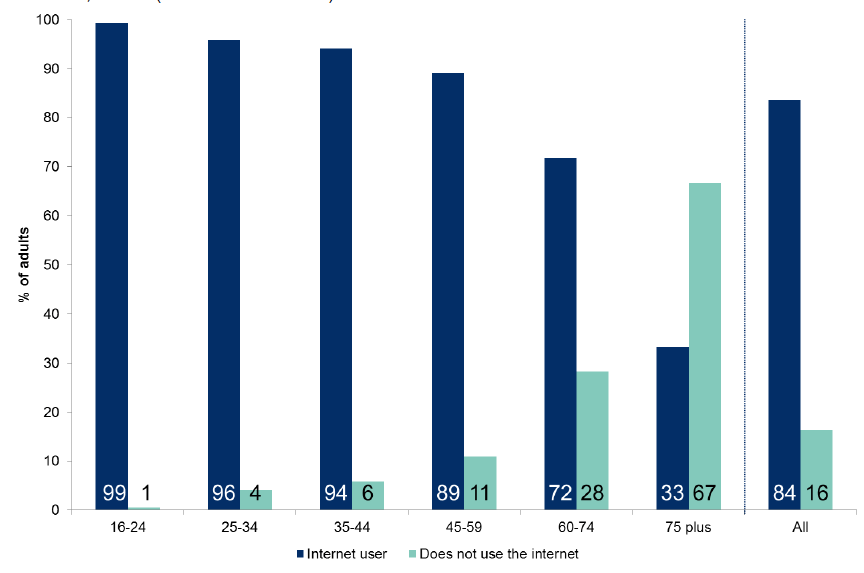
Variations in internet use: Health
- Poor health is a barrier to internet use.
Thirty-one per cent of those who have some form of a longstanding physical or mental health condition or illness reported not using the internet compared with 10 per cent of those who do not have any such condition ( Table 7.1). The result is more marked among the older age groups.
Table 7.1: Proportion of adults who do not use the internet by age and whether they have a physical or mental health condition lasting or expecting to last 12 months or more
Column percentages, 2016 data
| Does not have a physical or mental health condition or illness | Has a physical or mental health condition | All | |
|---|---|---|---|
| 16-24 | |||
| Internet user | 99 | 100 | 99 |
| Does not use the internet | 1 | 0 | 1 |
| Base | 300 | 70 | 370 |
| 25-34 | |||
| Internet user | 97 | 89 | 96 |
| Does not use the internet | 3 | 11 | 4 |
| Base | 500 | 100 | 600 |
| 35-44 | |||
| Internet user | 96 | 88 | 94 |
| Does not use the internet | 4 | 12 | 6 |
| Base | 580 | 170 | 740 |
| 45-59 | |||
| Internet user | 94 | 78 | 89 |
| Does not use the internet | 6 | 22 | 11 |
| Base | 790 | 350 | 1,140 |
| 60-74 | |||
| Internet user | 77 | 66 | 72 |
| Does not use the internet | 23 | 34 | 28 |
| Base | 650 | 540 | 1,190 |
| 75+ | |||
| Internet user | 39 | 30 | 33 |
| Does not use the internet | 61 | 70 | 67 |
| Base | 260 | 390 | 650 |
| All | |||
| Internet user | 90 | 69 | 84 |
| Does not use the internet | 10 | 31 | 16 |
| Base | 3,070 | 1,620 | 4,690 |
Excludes ‘Don’t know’/’Refused’ statements
Variations in internet use: Income
- Poorer households less likely to use the internet although the gap is lessening over time.
Figure 7.7 shows that, as with internet access, there is a broadly positive relationship between internet usage and income with the exception of the lowest income bracket – this feature is discussed in the internet access section. 3 per cent of adults living in a household with a total net income of £40,000 or more did not use the internet in 2016 compared with 36 per cent of those in the £6,001-£10,000 bracket. Since 2007, the gap in use between the lowest and highest income brackets has decreased from 57 per cent to 24 per cent in 2016.
Figure 7.7: Use of the internet by net annual household income
2016 data, Adults (minimum base: 120)
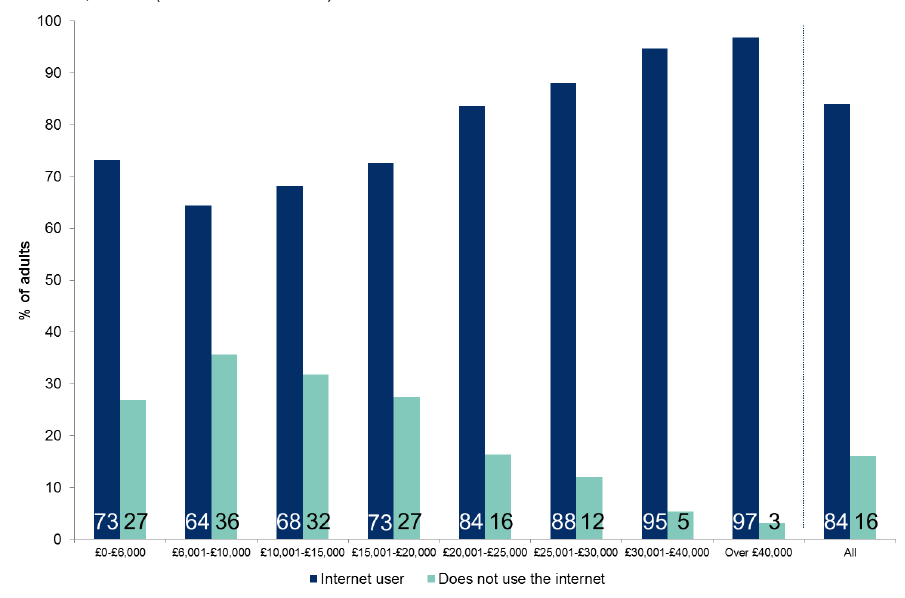
Variations in internet use: Deprivation
- People living in the most deprived areas of Scotland were less likely to use the internet.
As with internet access, there is a difference in internet usage by deprivation (Figure 7.8). 23 per cent of adults living in the 20 per cent most deprived areas in Scotland reported not using the internet compared with 15 per cent in the rest of the country.
Figure 7.8: Use of the internet by Scottish Index of Multiple Deprivation ( SIMD) 20 per cent most deprived areas
2016 data, Adults (minimum base: 930)
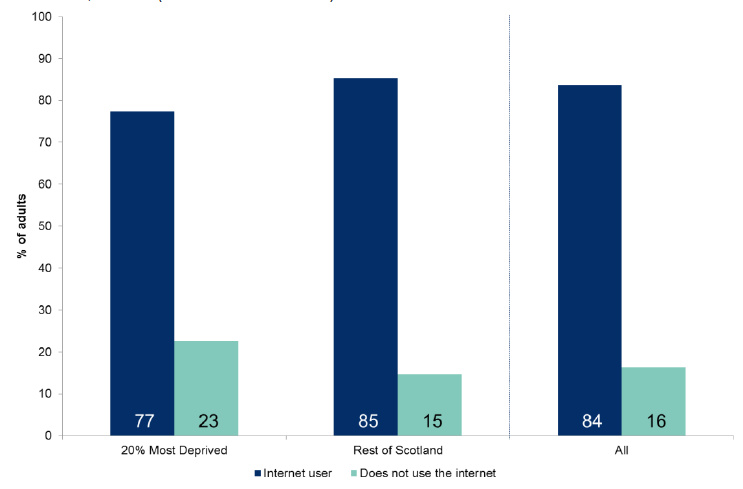
Variations in internet use: Tenure
- People living in social rented housing were less likely to use the internet.
Figure 7.9 shows that there was a difference in internet use by tenure. Thirty-one per cent of those in social rented housing reported not using the internet compared to only seven per cent of those in private rented housing and 14 per cent of those that own their own homes.
Figure 7.9: Use of the internet by tenure
2016 data, Adults (minimum base: 50)
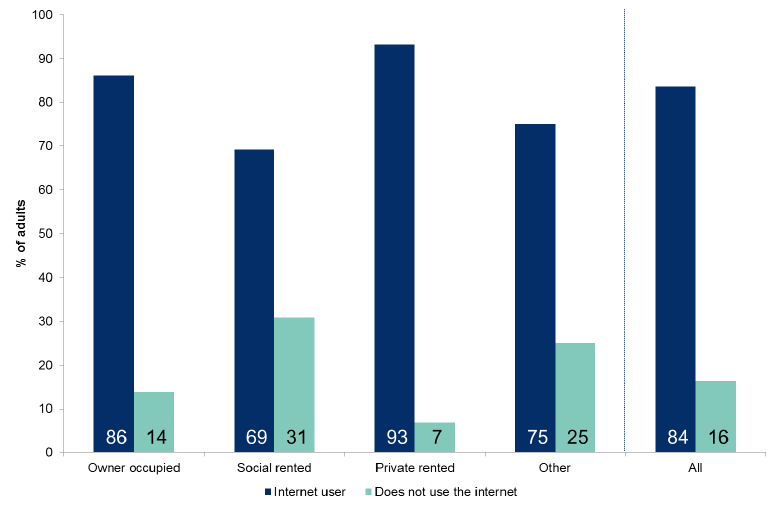
7.3 Where and How Users Access the Internet
- Access to the internet on the move via a mobile phone or tablet rose by six percentage points over the year to stand at 51 per cent in 2016.
The ways in which people access the internet are becoming increasingly diverse. Since 2007, the SHS has asked adults who use the internet for personal use about the location where they access it and the methods they use. Almost all adults (97 per cent) said that they use the internet at home ( Table 7.2). Access on the move via a mobile phone or tablet rose by six percentage points over the year to stand at 51 per cent in 2016. Over a quarter of adults (27 per cent) said that they made personal use of the internet at work.
Variations in methods used to access the internet: income
- Those on higher incomes were more likely to accessing the internet for personal use on the move via a phone or tablet.
There appears to be a broadly positive relationship between the proportion of people accessing the internet for personal use on the move via a phone or tablet and household income.
Table 7.2: Where adults who use the internet access it for personal use by annual net income
Column percentages, 2016 data
| Adults who make personal use of the internet | £0-£6,000 | £6,001-£10,000 | £10,001-£15,000 | £15,001-£20,000 | £20,001-£25,000 | £25,001-£30,000 | £30,001-£40,000 | Over £40,000 | All |
|---|---|---|---|---|---|---|---|---|---|
| At home | 88 | 90 | 93 | 96 | 98 | 97 | 99 | 99 | 97 |
| On the move via a mobile phone/smartphone/tablet | 45 | 41 | 42 | 40 | 48 | 52 | 52 | 61 | 51 |
| At work | 14 | 3 | 10 | 17 | 23 | 25 | 32 | 44 | 27 |
| At another person's home | 8 | 12 | 13 | 13 | 15 | 10 | 15 | 13 | 13 |
| School, college, university, other educational institution | 26 | 12 | 10 | 7 | 6 | 7 | 7 | 6 | 7 |
| Internet café or shop | 6 | 8 | 4 | 3 | 4 | 3 | 4 | 5 | 4 |
| Public library | 11 | 12 | 7 | 5 | 3 | 4 | 3 | 3 | 5 |
| Somewhere else | 3 | 1 | 1 | 0 | 1 | 1 | 2 | 1 | 1 |
| Community or voluntary centre/organisation | 4 | 1 | 0 | 1 | - | 1 | 1 | 0 | 1 |
| A government/council office | 0 | 0 | - | - | - | - | 1 | 1 | 1 |
| Base (minimum) | 60 | 170 | 340 | 320 | 320 | 250 | 380 | 520 | 2,340 |
Variations in methods used to access the internet: age
- Already very high (in 2015) tablets and mobile phones use among 25-34 year olds maintained.
- The use of mobile phones to access the internet increased by 9 percentage points amongst 60-74 year olds between 2015 and 2016.
Table 7.3 shows which methods are used to access the internet for personal use by age. The proportion of adults reporting that they access the internet using personal computers or laptops remained broadly stable over the years (80 per cent in 2016 compared to 81 per cent in 2015). The proportion of adults accessing the internet by any means other than a personal computer or laptop (including tablets and mobile phones) continued to increase over the year, from 81 per cent in 2015 to 84 per cent in 2016.
There was very little change in access by means other than a personal computer or laptop among 25-34 year olds, where uptake was already very high in 2015. However there was an increase of nine percentage points in access by these ‘other’ means among 60-74 year olds. The ‘other’ technologies used are overwhelmingly tablets and mobile phones amongst all age brackets.
Table 7.3: Where adults who use the internet for personal use access it by age
Column percentages, 2016 data
| Adults who make personal use of the internet | 16-24 | 25-34 | 35-44 | 45-59 | 60-74 | 75 plus | All |
|---|---|---|---|---|---|---|---|
| A personal computer or laptop | 78 | 80 | 76 | 81 | 83 | 83 | 80 |
| Digital, cable or satellite television | 13 | 16 | 15 | 11 | 9 | 1 | 12 |
| Mobile phone/iPhone/Smartphone | 93 | 87 | 80 | 70 | 45 | 16 | 72 |
| A games console/PS2/xBox | 25 | 18 | 11 | 6 | 1 | - | 11 |
| A tablet - iPad/Playbook or similar | 43 | 51 | 58 | 54 | 55 | 53 | 52 |
| Another way | 1 | 0 | 0 | 0 | 0 | - | 0 |
| Other than a personal computer or laptop | 96 | 91 | 89 | 79 | 70 | 61 | 84 |
| Base (minimum) | 250 | 380 | 450 | 640 | 540 | 160 | 2,420 |
Common internet activities
- The top three internet activities are sending and receiving emails, searching for information and buying goods or services.
As shown in Table 7.4, the most common activities undertaken by those who have access to the internet include sending and receiving emails (90 per cent of all adults who make personal use of the internet), searching for information (80 per cent), buying goods or services (74 per cent), using social media (68 per cent) and internet banking (62 per cent). Those in social rented housing were less likely than average to use the internet for banking, buying goods and services, making telephone or video calls and sending and receiving emails.
Table 7.4: Which methods are used to access the internet for personal use by tenure
Column percentages, 2016 data
| Adults who make personal use of the internet | Owner occupied | Social rented | Private rented | Other | All |
|---|---|---|---|---|---|
| Send and receive e-mails | 90 | 82 | 95 | * | 90 |
| Search for information | 81 | 76 | 84 | * | 80 |
| Buy goods or services | 76 | 59 | 81 | * | 74 |
| Use social media | 65 | 71 | 81 | * | 68 |
| Internet banking | 62 | 51 | 74 | * | 62 |
| Play or download games, films or music | 49 | 52 | 64 | * | 52 |
| Make telephone/video calls over the internet | 44 | 37 | 57 | * | 45 |
| Look for/apply for jobs | 24 | 28 | 39 | * | 27 |
| Create websites or blogs | 10 | 6 | 16 | * | 10 |
| None of these | 1 | 1 | - | * | 1 |
| Base (minimum) | 1,590 | 430 | 360 | 30 | 2,420 |
Confidence in using the internet
- Adults in social housing, older people and poorer people were less confident in their ability to use the internet.
Among those that have access, a lower proportion of adults in social housing were very or fairly confident in their ability to use the internet across all activities discussed than those in private rented housing and those who own their own home ( Table 7.5). Those aged over 45 and those on incomes between £6,000-£20,000 consistently reported being less confident than average across all activities.
Table 7.5: Confidence in pursuing activities when using the internet by tenure
Column percentages, 2016 data
| Adults who make personal use of the internet | Owner occupied | Social rented | Private rented | Other | All |
|---|---|---|---|---|---|
| Send and receive e-mails | 94 | 87 | 96 | * | 93 |
| Use a search engine | 96 | 94 | 99 | * | 96 |
| Shop online | 88 | 78 | 94 | * | 87 |
| Use public services online | 86 | 78 | 89 | * | 85 |
| Identify and delete spam | 83 | 74 | 86 | * | 82 |
| Be able to tell what websites to trust | 81 | 73 | 86 | * | 81 |
| Control privacy settings online | 78 | 71 | 84 | * | 78 |
| Base (minimum) | 1,550 | 410 | 350 | 30 | 2,330 |
7.4 Why People Do Not Use the Internet
Among those adults who make no personal use of the internet, not liking or not needing to use the internet/computers remained the most commonly reported reasons for non- use.
Table 7.6: Reasons why people might not use the internet (other than work)
Column percentages, 2016 data
| Adults who make no personal use of the internet | |
|---|---|
| I don't like using the internet or computers | 34 |
| I don't need to use the internet or computers | 33 |
| I don't know how to use a computer | 24 |
| There's nothing of interest to me on the internet | 21 |
| It would be too difficult to learn how to use the internet | 9 |
| I prefer to do things in person rather than use computers | 8 |
| I can't afford a computer | 7 |
| Other reason | 5 |
| I am concerned about privacy e.g. keeping credit card or personal details safe | 4 |
| I have a disability or illness that prevents me | 4 |
| Internet connection would be too expensive | 2 |
| I am worried about unsuitable or inappropriate material on the internet | 2 |
| Base (minimum) | 710 |
7.5 Use of Security Measures
Since 2015, the SHS has asked about the security measures adults take to protect themselves whilst online and how security concerns are impacting internet use.
7.5.1 Security Measures Used Online
- Two-thirds of adults indicated that they avoid opening emails or attachments from unknown people.
- Only around a third said they regularly change passwords for online accounts or make sure their mobile phone has up-to-date antivirus software.
- The proportion of internet users who say they back-up important information which increased from 40 per cent to 43 per cent.
Some online security measures appear to be used more widely than others. For example, whilst just over two-thirds of adults (68 per cent) indicated that they avoid opening emails or attachments from unknown people, only around a third said they make sure their mobile phone has up-to-date antivirus software (34 per cent) or regularly change passwords for online accounts (33 per cent). The only measure where there was any change between 2015 and 2016 was in the proportion of internet users who say they back-up important information which increased from 40 per cent to 43 per cent.
Variation in the use of online security measures: age
- Older people were less likely to adopt security measures.
Use of online security measures varies by age, with those aged 60 and above generally less likely to adopt each of the measures than those in younger age groups as shown in Table 7.7. In particular, adults aged 75+ were notably less likely to adopt any of the security measures, with 23 per cent saying that they did not take any of the suggested actions. Moreover, whilst 59 per cent of those aged 16-24 said that they back-up important information, this was the case for only 34 per cent of those aged 60-75 and 22 per cent of those aged 75 and above.
Variation in the use of online security measures: deprivation
- Those in the most deprived areas were less likely to adopt security measures.
In general, adults living in the 20 per cent most deprived areas of Scotland were less likely than those in the rest of Scotland to adopt online security measures.
Table 7.7: Online security measures by age and deprivation
Column percentages, 2016 data
| Adults | 16-24 | 25-34 | 35-44 | 45-59 | 60-74 | 75 plus | 20% Most Deprived | Rest of Scotland | All |
|---|---|---|---|---|---|---|---|---|---|
| Download and install software updates/patches when prompted | 61 | 60 | 60 | 59 | 48 | 44 | 46 | 60 | 57 |
| Avoid opening emails or attachments from unknown people | 70 | 72 | 71 | 69 | 64 | 54 | 60 | 70 | 68 |
| Use different passwords for different accounts | 66 | 64 | 69 | 66 | 60 | 36 | 57 | 66 | 64 |
| Set complex passwords | 71 | 60 | 55 | 50 | 43 | 31 | 45 | 56 | 54 |
| Change passwords for online accounts regularly | 39 | 34 | 38 | 35 | 24 | 16 | 38 | 32 | 33 |
| Avoid giving personal information online | 72 | 67 | 70 | 66 | 62 | 57 | 59 | 69 | 67 |
| Make sure my computer has up-to-date anti-virus software | 60 | 58 | 64 | 63 | 61 | 56 | 55 | 62 | 61 |
| Make sure my mobile phone has up-to-date anti-virus software | 40 | 40 | 44 | 31 | 24 | 12 | 35 | 34 | 34 |
| Make sure my home wi-fi is protected with a username and password | 62 | 62 | 61 | 58 | 53 | 41 | 47 | 61 | 58 |
| Back-up important information | 59 | 48 | 44 | 39 | 34 | 22 | 34 | 45 | 43 |
| None of these | 2 | 5 | 3 | 8 | 13 | 23 | 9 | 6 | 7 |
| Base (minimum) | 250 | 380 | 450 | 640 | 540 | 160 | 440 | 1,970 | 2,420 |
Columns may not add to 100 per cent since multiple responses were allowed.
7.5.2 Impact of Security Concerns on Internet Use
- There has been an increase in the proportion reporting that security concerns made them less likely to buy goods online.
- Younger people (particularly those aged 16-24) were less likely to have changed their use of the internet as a result of security concerns.
- The SHS explores whether concerns about security issues have made people change the way they make use of the internet. Since 2015, there has been an increase in the proportion reporting that security concerns made them less likely to buy goods online, from eight per cent in 2015 to 11 per cent in 2016.
Table 7.8 shows that, in general, younger people (particularly those aged 16-24) were less likely to have changed their use of the internet as a result of security concerns. For example, only six per cent of those aged 16-24 reported that security concerns made them less likely to bank online, compared to 20 per cent of those aged between 60-74 and 25 per cent of those aged 75 and above.
The impact of security concerns on various types of internet usage was generally greater for those with a long-term physical or mental health condition. For example, 20 per cent of those with a long-term condition reported that they were less likely to bank online compared to 12 per cent of those without such a condition.
Table 7.8: Impact of security concerns on internet use by age and physical or mental health condition
Column percentages, 2016 data
| Adults | Age | Long -term physical or mental health condition or illness | All | ||||||
|---|---|---|---|---|---|---|---|---|---|
| 16-24 | 25-34 | 35-44 | 45-59 | 60-74 | 75+ | Yes | No | ||
| Less likely to buy goods online | 8 | 8 | 8 | 13 | 14 | 20 | 15 | 9 | 11 |
| Less likely to bank online | 6 | 10 | 10 | 18 | 20 | 25 | 20 | 12 | 14 |
| Less likely to give personal information on websites | 30 | 24 | 36 | 40 | 35 | 44 | 38 | 33 | 34 |
| Only visit websites you know and trust | 26 | 28 | 32 | 38 | 29 | 40 | 36 | 31 | 32 |
| Only use your own computer/mobile device | 13 | 16 | 21 | 28 | 26 | 29 | 28 | 20 | 22 |
| Less likely to use the internet | 1 | 2 | 2 | 5 | 6 | 12 | 7 | 3 | 4 |
| No, none of the above | 55 | 54 | 45 | 38 | 43 | 35 | 39 | 48 | 46 |
| Base (minimum) | 250 | 380 | 450 | 640 | 540 | 160 | 660 | 1,760 | 2,420 |
Conclusion
This chapter has summarised Scottish Household Survey findings on the internet.
Contact
Email: Emma McCallum, emma.mccallum@gov.scot
Phone: 0300 244 4000 – Central Enquiry Unit
The Scottish Government
St Andrew's House
Regent Road
Edinburgh
EH1 3DG
There is a problem
Thanks for your feedback